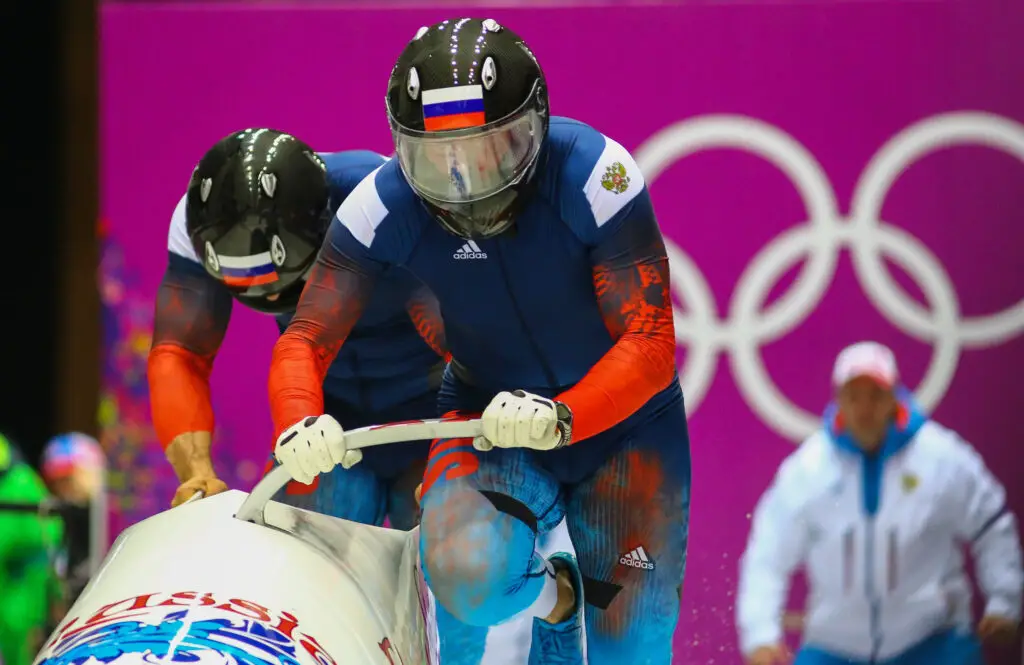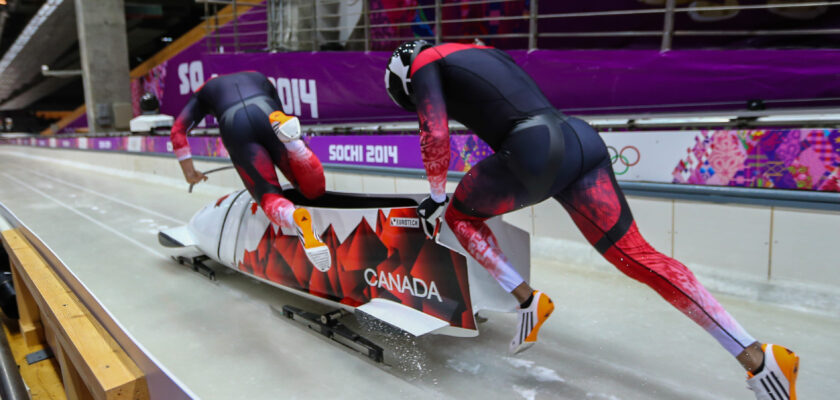Although Brazil doesn’t have a great tradition in winter sports, bobsled – also known as bobsleigh – has gained notoriety in the country, albeit for an unexpected reason. If you’re curious to learn more about this peculiar sport, fasten your seatbelts and get ready for a high-speed journey to learn all about bobsled!

Open your Betano account and get up to 1,000 reais in bonuses.
Payments via PIX, live games and super odds!
Click here to open your account!
All about Bobsled: what is it?
The “Formula 1 of Ice”, as it is known, bobsled is a team winter sport, performed in pairs and quartets that descend on sleds down ice tracks;
In the competitions, each team makes two to four descents, and the team with the shortest total time is the winner.
Continue reading to find out all about bobsled!
All about Bobsled: origin and history
The sport has its roots in the 19th century, when sledges began to be used as a means of transportation in the snowy mountains.
In the 1870s, Caspar Badrutt, owner of a hotel in St. Moritz, Switzerland, built the first track dedicated to sled dog racing – which is still in use today and is one of the few tracks in the world that doesn’t use artificial ice.
Evolution of Bobsled sleds
Chassis were incorporated to provide more safety for tourists and the first competitions appeared at the end of the nineteenth century. Originally, the first races used wooden skeleton sleds.
However, these were replaced by steel sleds, called “bobsleds” due to the back and forth jerking motion the crew made to gain speed at the start of the race.
Today, the top teams train and compete on artificial ice rinks all year round, using high-tech sleds made of steel and fiberglass.
Continue reading to find out all about bobsled!
Following years until today
The International Bobsled and Skeleton Federation (IBSF) was founded in 1923 and, the following year, bobsled was included in the first edition of the Winter Olympics. Since then, the sport has been a constant presence on the Olympic program;
In 1924, during the Winter Olympics in Chamonix, the first bobsled competition for four-man teams took place.
In 1932, at the Lake Placid Games, the men’s doubles event was added, a format that has continued to this day. The first women’s doubles bobsled competition took place in 2002.
In the 1950s, the importance of fast starts was recognized, and athletes with explosive strength from other sports began to take an interest in bobsled.
In 1952, a rule was implemented to limit the total weight of the team, marking the end of the era of super-heavy athletes and bringing a greater focus on the athletic context of the sport.
Currently, the competitions include men’s and women’s doubles, as well as quartets, usually made up of four men (but since 2015, the International Federation has allowed women to participate in the quartets);
Continue reading to find out all about bobsled!
All about Bobsled: strategies and rules of the sport
The strategy in bobsled is very similar between the teams. Understand:
Strategies
After the start, competitors must quickly get on the sled, lower their heads into an aerodynamic position and maintain efficiency throughout the course;
Variations in strategies arise when the brake, operated by the breakman or breakwoman, is applied in certain bends to avoid collisions, or when the decision is to maintain speed in order to achieve a faster time.
In addition to having fast reflexes and memorizing the route of the ice rink well, the racers need to identify the ideal racing line to avoid accidents and maintain maximum speed;
The teams are timed, and their times are compared with those of the other teams completing the same course;
In competitions, usually two to four races are run to determine the lowest combined time and, consequently, the winning team.
When watching a bobsled competition you’ll hear terms like:
- 2-man: men’s doubles competition.
- 4-man: quartet competition, usually made up of four men.
- Breakman or breakwoman: team member responsible for braking the sled after the team crosses the finish line.
- Push: the start, in which athletes push the sled with their hands to gain speed before entering the equipment. This initial push covers a distance of 50 meters.
Continue reading to find out all about bobsled!
Rules
The first rule concerns weight. The athletes and the sled together may not exceed 390 kg in the 2-man event, 340 kg in the 2-woman event and 630 kg in the 4-man event.
All team members must wear high-tech helmets, sports uniforms and special shoes.
In order for international competitions to be held, bobsled tracks must be regulated by the International Bobsled and Skeleton Federation (IBSF) and be between 1,200 and 1,600 meters long.
The referee, in addition to timing and declaring the winner, must ensure that the tracks are up to standard and ready for a safe competition.
Read on to find out all about bobsled!
All about Bobsled: sports equipment
If you’ve ever watched bobsled videos, you’ll know that the sport requires specific equipment and a sturdy structure to be practiced safely;
Here are four essential items for a good performance by bobsled athletes:
- Sleds: the first sleds were made of wood, without side reinforcements. Nowadays, sleds have a steel frame and a carbon-kevlar fiber body, similar to Formula 1 cars. They have four blades at the bottom (two fixed at the rear and two movable at the front, controlled by the rider).
- Sneakers: lightweight and made of synthetic material, they have between 500 and 600 needles that help with traction and balance during the push off.
- Helmets: essential for the safety of athletes in speed sports, some models include an attached visor to protect the eyes.
- Retractable handles: located on the sides, are used to push the sled at the start of a bobsled run.
Continue reading to find out all about bobsled!
All about Bobsled: Brazil in bobsled
Created in 1996 with the emergence of the Associação Brasileira de Bobsled, Skeleton e Luge (ABBSL), the forerunner of the CBDG, the Brazilian bobsled and skeleton team is the country’s most successful team in ice sports.
Activities began soon after the organization was set up, with the formation of men’s teams in the doubles and foursomes categories;
The first competitions took place in the 1996/199 season7, with stages of the America’s Cup. In 1998, the Brazilian bobsled team obtained the Olympic index, but was unable to compete due to bureaucratic issues.
In more than two decades, the disciplines have accumulated significant achievements, including:
- 2 bronze medals at the 2016 Bobsled Push World Championships;
- 27 medals in international competitions (eleven gold, three silver and 13 bronze);
- 5 appearances in the World Cup season (02/03, 05/06, 14/15, 15/16 and 16/17);
- 4 World Cup appearances (2003, 2011, 2015 and 2016).
Brazil was present at the Olympic Games in 2002 (Salt Lake City), 2006 (Turin), 2014 (Sochi) and 2018 (PyeongChang) with the bobsled team;
The country also competed in the 2016 Winter Youth Olympic Games (Lillehammer) in the skeleton and monobob disciplines.
Continue reading to find out all about bobsled!
All about Bobsled: the best teams today
Currently, the main bobsled teams on the international scene are those from Germany, the United States, Canada and Switzerland.
The German team is particularly dominant, having won 11 of the 12 medals at the last world championships;
Francesco Friedrich, one of the biggest names in the sport, leads the team with a record of 14 world titles in two- and four-person events, as well as gold in the last two Olympics;
Athletes Lisa Buckwitz and Vanessa Mark also stand out in the women’s team, contributing to Germany’s impressive medal haul.
The United States also has a strong presence, especially with athletes such as Elana Meyers Taylor, who recently won silver in the monobob at the world championships, becoming the oldest woman to win a medal in that competition.
The American team continues to be competitive in both the men’s and women’s events.
Continue reading to find out all about bobsled!
Canada continues its tradition of bobsled success, with a long history of Olympic and world championship medals;
Recently, Canadian teams have achieved good results at various stages of the World Cup.
Switzerland, a pioneer in bobsled, continues to be a force in the sport, with outstanding athletes in various international competitions, remaining among the best in the world in terms of performance and consistency.
Now that you know all about bobsled, get to know other sports you don’t know yet:



